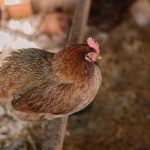Raising baby chickens, or chicks, requires careful attention to their specific needs. Chicks need a warm, draft-free environment with consistent temperature control, as they are highly sensitive to temperature fluctuations. A proper brooding area should be set up with appropriate heat sources, such as heat lamps, to maintain the required temperature.
Adequate nutrition is crucial for chick development. Provide them with a high-quality starter feed formulated specifically for their age and ensure constant access to fresh, clean water. The feeding and watering equipment should be appropriate for their size and easily accessible.
Bedding material is essential for chick comfort and hygiene. Use absorbent materials like pine shavings or straw, and change it regularly to maintain a clean living space. As chicks grow, they will need more space to move around and explore.
Proper ventilation is important to prevent the buildup of harmful gases and maintain air quality. However, ensure that ventilation does not create drafts that could chill the chicks. Monitor the chicks closely for signs of illness or distress, and be prepared to adjust their environment as needed.
With proper care and attention to these requirements, baby chickens can grow into healthy, robust adults.
Table of Contents
- 1 Providing a warm and draft-free environment
- 2 Using heat lamps or heating pads
- 3 Insulating the chicken coop
- 4 Monitoring temperature and adjusting as needed
- 5 Providing additional bedding and nesting material
- 6 Ensuring adequate ventilation
- 7 FAQs
- 7.1 What temperature should baby chickens be kept at night?
- 7.2 How can I keep baby chickens warm at night?
- 7.3 What should I use as bedding for baby chickens at night?
- 7.4 Should I provide extra heat for baby chickens if it’s particularly cold at night?
- 7.5 What are the signs that baby chickens are too cold at night?
Key Takeaways
- Baby chickens need a warm and draft-free environment to thrive
- Heat lamps or heating pads can be used to provide the necessary warmth
- Insulating the chicken coop helps maintain a stable temperature
- Regularly monitor the temperature and make adjustments as needed
- Provide additional bedding and nesting material for comfort and warmth
- Ensure adequate ventilation to maintain air quality and prevent moisture buildup
Providing a warm and draft-free environment
Insulation is Key
A well-insulated brooder is crucial in maintaining a warm and cozy environment for baby chickens. This can be achieved by using insulating materials such as straw, hay, or shredded newspaper to line the brooder. Additionally, covering the brooder with a tarp or blanket can help to retain heat and keep drafts out.
A Consistent Heat Source
In addition to insulation, providing a consistent heat source is vital in keeping baby chickens warm. Heat lamps or heating pads can be used to provide a reliable source of warmth. These can be placed in the brooder to maintain a consistent temperature, ensuring that the chicks stay warm and comfortable.
A Healthy and Happy Start
By providing a warm and draft-free environment, you can help baby chickens stay healthy and comfortable as they grow. A well-cared-for chick is more likely to develop into a strong and healthy adult chicken. By following these simple steps, you can give your baby chickens the best possible start in life.
Using heat lamps or heating pads

One of the most effective ways to provide baby chickens with the warmth they need is by using heat lamps or heating pads. Heat lamps are a popular choice for providing warmth to baby chickens, as they can be easily adjusted to provide the right amount of heat for the chicks. Heating pads are another option for providing warmth, as they can be placed underneath the bedding in the brooder to create a warm and cozy environment for the chicks.
When using heat lamps or heating pads, it’s important to monitor the temperature in the brooder regularly to ensure that it remains at the appropriate level for the chicks. It’s also important to position the heat source in a way that allows the chicks to move away from it if they become too warm. By using heat lamps or heating pads, you can provide baby chickens with the warmth they need to thrive and grow.
Insulating the chicken coop
In addition to providing a warm and draft-free environment in the brooder, it’s also important to insulate the chicken coop to ensure that baby chickens stay warm as they grow. Insulation can help to regulate the temperature inside the coop, keeping it warm in the winter and cool in the summer. This can help to create a comfortable environment for the chickens year-round.
There are several different types of insulation that can be used in a chicken coop, including fiberglass insulation, foam board insulation, and reflective insulation. Each type of insulation has its own benefits and drawbacks, so it’s important to choose the right option for your specific needs. By insulating the chicken coop, you can help to ensure that baby chickens stay warm and comfortable as they grow.
Monitoring temperature and adjusting as needed
Once you have provided baby chickens with a warm and draft-free environment, it’s important to monitor the temperature in the brooder or chicken coop regularly and make adjustments as needed. This can be done using a thermometer to measure the temperature in the space where the chicks are living. It’s important to keep the temperature within a specific range that is appropriate for baby chickens, which is typically between 90-95 degrees Fahrenheit for the first week of life, with a gradual decrease of 5 degrees per week until they are fully feathered.
If the temperature in the brooder or chicken coop is too low, you can adjust the heat source to provide more warmth for the chicks. If the temperature is too high, you can adjust the heat source or provide additional ventilation to help cool down the space. By monitoring the temperature regularly and making adjustments as needed, you can ensure that baby chickens stay comfortable and healthy as they grow.
Providing additional bedding and nesting material

Bedding Material for Comfort and Security
In addition to providing a warm and draft-free environment, it’s essential to provide baby chickens with plenty of bedding material. This can help keep them comfortable and secure, as well as provide a place to rest and sleep. Bedding material such as pine shavings or straw can be used to create a soft and cozy environment for the chicks.
Nesting Material for Growing Chickens
Nesting material such as shredded paper or hay can also be provided to give baby chickens a place to nest and lay eggs as they grow older. This is an essential aspect of their development and will help them feel safe and secure in their environment.
Benefits of Providing Bedding and Nesting Material
By providing plenty of bedding and nesting material, you can help baby chickens feel safe and secure in their environment, which can contribute to their overall health and well-being. This is crucial for their development and will help them grow into healthy and happy chickens.
Ensuring adequate ventilation
While it’s important to provide baby chickens with a warm and draft-free environment, it’s also important to ensure that there is adequate ventilation in the brooder or chicken coop. Good ventilation can help to remove excess moisture from the air, which can help prevent respiratory issues in baby chickens. It can also help regulate the temperature inside the space, keeping it comfortable for the chicks.
Adequate ventilation can be achieved by providing vents or windows in the chicken coop that can be opened or closed as needed. It’s important to monitor the humidity levels inside the coop and make adjustments as needed to ensure that there is enough ventilation for the chicks. By ensuring adequate ventilation, you can help baby chickens stay healthy and comfortable as they grow.
If you’re looking for more tips on keeping baby chickens warm at night, check out this article on how to build a garden chicken coop from PoultryWizard.com. This resource provides valuable information on creating a safe and cozy environment for your chickens, which is essential for their well-being, especially during the colder months. Additionally, you can also learn about converting a shed into a chicken coop to provide even more space and protection for your feathered friends.
FAQs
What temperature should baby chickens be kept at night?
Baby chickens should be kept at a temperature of around 95°F (35°C) for the first week of their life. The temperature can then be reduced by 5°F (2.8°C) each week until they are fully feathered, usually around 6 weeks of age.
How can I keep baby chickens warm at night?
There are several ways to keep baby chickens warm at night. You can use a heat lamp, a brooder, or a heating pad specifically designed for baby chicks. It’s important to provide a warm, draft-free environment for the chicks to prevent them from getting chilled.
What should I use as bedding for baby chickens at night?
Pine shavings or straw are commonly used as bedding for baby chickens. These materials provide insulation and help to keep the chicks warm at night. It’s important to keep the bedding clean and dry to prevent the chicks from getting sick.
Should I provide extra heat for baby chickens if it’s particularly cold at night?
If the temperature drops significantly at night, it may be necessary to provide extra heat for baby chickens. This can be done by increasing the wattage of the heat lamp or adding additional heating sources to the brooder. It’s important to monitor the temperature closely and make adjustments as needed to ensure the chicks stay warm.
What are the signs that baby chickens are too cold at night?
Signs that baby chickens are too cold at night include huddling together, chirping loudly, and appearing lethargic. It’s important to address any signs of cold stress in chicks promptly to prevent them from becoming chilled.
Meet Walter, the feathered-friend fanatic of Florida! Nestled in the sunshine state, Walter struts through life with his feathered companions, clucking his way to happiness. With a coop that’s fancier than a five-star hotel, he’s the Don Juan of the chicken world. When he’s not teaching his hens to do the cha-cha, you’ll find him in a heated debate with his prized rooster, Sir Clucks-a-Lot. Walter’s poultry passion is no yolk; he’s the sunny-side-up guy you never knew you needed in your flock of friends!







